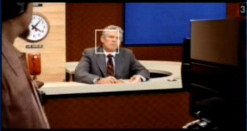

[NetworkPoints -- Video A (2.4 MB)]
Points of regard (gaze points) of 5 normally sighted observers recorded while watching one minute of the movie Network. This clip is the "News" category and contains little motion with long segments containing seated talking protagonists. Features to note about the eye movements are (a) gaze points tend to cluster around faces; (b) occasional bimodal distributions can be observed (16-19 seconds into the clip) where some observers look at one face and others at another face; (c) there is a noticeable delay before the gaze points all settle around a common center of interest; (d) blinks are present as indicated by a gaze point making a downward motion followed by an immediate return to the cluster of gaze points; (e) occasional outliers can be observed where one observer is looking at another area than the rest; and (f) during periods of motion, the gaze points track the main protagonist through the scene (seconds 40-58).

[NetworkBoxes -- Video B (2.2 MB)]
Squares representing the BVCEA of 20 normally sighted subjects watching the same one minute of the movie Network as presented in Video A. The centers of the squares are positioned at the center of interest (COI), and the sizes of the squares are calculated to equal the area of the bi-variate contour ellipse area (BVCEA). Features to note about the squares are (a) for this mostly static clip, the variability in the area is greater than in a movie of much motion such as Any Given Sunday (Video D); (b) the position of the COI is at times far from the center of the screen (for example the first 3 and last 5 seconds); and (c) when there is a possible bimodal COI, the BVCEA tends to encompass both possible COIís.

[SundayPoints -- Video C (1.4 MB)]
Points of regard of 5 normally sighted observers while watching 31 seconds of the movie Any Given Sunday. This clip is in the "Sports" category and contains many segments of high motion and frequent scene cuts. Features to note about the eye movements are (a) gaze points do not have time to settle on a precise COI; (b) although there is high motion depicted, the moving COI is primarily at the center of the screen; (c) blinks are present as indicated by a gaze point making a downward motion followed by an immediate return to the cluster of gaze points; and (d) occasional outliers can be observed.

[SundayBoxes -- Video D (1.4 MB)]
Squares representing the BVCEA of 20 normally sighted subjects watching the same 31 seconds of the movie Any Given Sunday as presented in Video C. The centers of the squares are positioned at the COI, and the sizes of the squares are calculated to equal the area of the BVCEA. Features to note about the COI are (a) for this clip, the variability in the area is smaller than in a movie of little motion such as Network (Video B); (b) the centers of the squares tend to stay closer to the center of the screen than in Network. This is because much of the motion within the scene was compensated for by camera motion, which tracked the moving objects and kept it in the center of the screen.